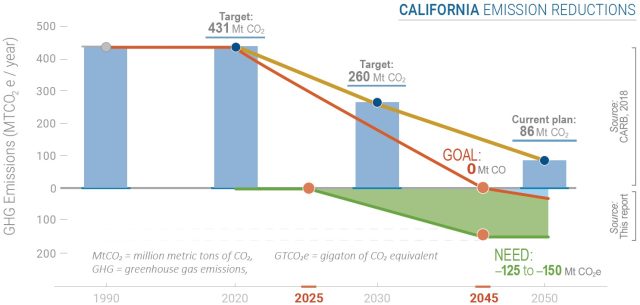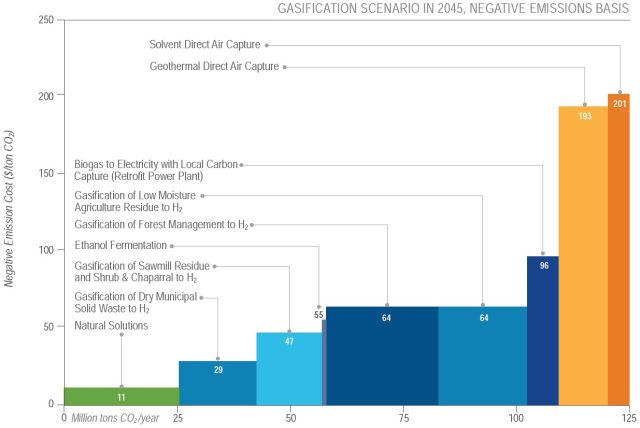
In September 2018, California Governor Jerry Brown set a greenhouse goal for the state: net-zero emissions by 2045. It's a very aggressive goal. The easiest part of the energy transition is the first bit: growing the meager share of renewables on the grid. But cleaning up the last 20 percent or so of our energy use is a bigger challenge and one that has yet to be tackled. From industry to air travel to agriculture, some things look like a very heavy lift.
However, achieving net-zero emissions is easier than "actual" zero because activities that actively remove CO2 from the atmosphere (sometimes called "negative emissions") could cancel out some of the stubborn emissions we can't get rid of. To find out how that might work in California's case, a Lawrence Livermore National Laboratory report analyzed options to estimate costs. It points to a hefty—though not impossible—price tag to meet that 2045 goal.
Drawdown
The first question is just how much CO2 California is going to need to suck out of the atmosphere to achieve its goal. The Golden State's current plan is to see emissions cut from over 400 million tons per year to about 86 million tons by 2050. To hit net-zero in that case, negative emissions would have to grow to 125 million tons per year by 2045.

The report works out the cheapest and most plausible combination of negative emissions to reach 125 million tons. About 25 million tons per year could come from land management. Another 84 million tons could be provided by a system producing fuels and capturing CO2 from organic waste like crop stalks and brush cleared for fire hazard reduction. The final 16 million tons would be handled by facilities that use industrial processes to capture CO2 from ambient air—which currently exist only as pilot projects.
Land management includes a range of activities, some of which are really cheap. Restoring some agricultural land to grassland or wetland, for example, would allow it to soak up a bunch of carbon. And altering the way that logged forests are managed by allowing longer growth cycles between harvests, or selectively removing dead trees to make space for something to grow, would also remove some carbon from the atmosphere.
About four of the 25 million tons per year in this category relate to increasing the carbon accumulation in soils. That could include trading out some annual crops for perennials that grow bigger roots and reduce the need for tilling up the soil. Compost or even charcoal produced from plant waste can also be added to the soil as an input, improving soil quality while contributing to negative emissions.
The future of carbon
After that, the story gets a little more unconventional. The biggest share of negative emissions in the report comes from "waste biomass conversion." This can take several forms, but the report highlights hydrogen fuel production as the top option. Heating organic material to a high temperature in controlled conditions that prevent combustion produces carbon monoxide, CO2, and hydrogen gas. The hydrogen gas can be separated for use as a fuel, and the rest can be stored underground.
The report notes that the hydrogen doesn't even necessarily have to be sent off to specific hydrogen-burning applications (although it could). A fair amount of hydrogen can be injected right into existing natural gas pipelines without the need for any changes.
As for the biomass feeding this process, the report identifies about 13 million tons of agricultural chaff each year, 13 million tons of things like lumber and cardboard thrown out every year, and 24 million tons of brush cut to reduce wildfire hazards. This would provide a market to pay for material from brush-cutting—something sorely lacking at present. Finally, the report includes sewage and manure digesters producing biogas.
The other big strategy would be "direct air capture" plants, which filter air through a chemical process that captures and separates CO2 gas. This is currently the most expensive option for obtaining carbon dioxide, but it has the advantage of scaling about as much as you'd like. Because this technology is in the early stages, there's plenty of room for that price to come down. The report actually suggests that California could "buy down" the cost by providing the early investment the technology needs to mature. Specifically, it estimated that the cost per ton of CO2 would drop 20-30 percent after the first few plants were built.

A to B to CO2
That leaves two logistical questions: how are all these solid materials and gases going to be transported, and where will the captured CO2 be dumped?
For all that brush and agricultural waste, rail is the cheapest way to move it around. But rather than a random scattering of facilities that process this or handle that, the report envisions a centralized trunk line down the middle of the state along which everything would be located. This way, trucks wouldn't have to travel very far to reach a railroad, which could carry it along that trunk line.
Along that central line, there would be a single CO2 pipeline. Gasification plants would process biomass and push their captured CO2 into the pipeline, which would carry it to the storage facilities that would pump it under ground. Just as California has some oil and gas resources, it has rocks suitable for holding and trapping CO2. Injected to sufficient depth (where the pressure is great), CO2 becomes denser, losing interest in buoyantly bubbling upward.
The report estimates that California has enough geologic capacity to accept at least 100 years of CO2 capture at the rate being discussed here. And the plan should be to eliminate the need for carbon storage in that time, anyway.
The estimated overall cost for the variety of actions outlined in the report, which would bring California to net-zero emissions by 2045, is about $8 billion per year. While no one will be excited to squeeze $8 billion into a budget, the report notes that this is just 0.4 percent of the state's current GDP. Or for another comparison, it's equal to a little over 5 percent of the state's current tax revenue.
Of course, if the state failed to follow through on emissions reductions, it could cost a whole lot more to counter that extra carbon.
"Here" - Google News
February 05, 2020 at 05:12AM
https://ift.tt/2ulZnKh
Here’s what it could cost for California to hit zero-emissions goal - Ars Technica
"Here" - Google News
https://ift.tt/39D7kKR
Shoes Man Tutorial
Pos News Update
Meme Update
Korean Entertainment News
Japan News Update
:no_upscale()/cdn.vox-cdn.com/uploads/chorus_asset/file/25244079/4.png)
No comments:
Post a Comment